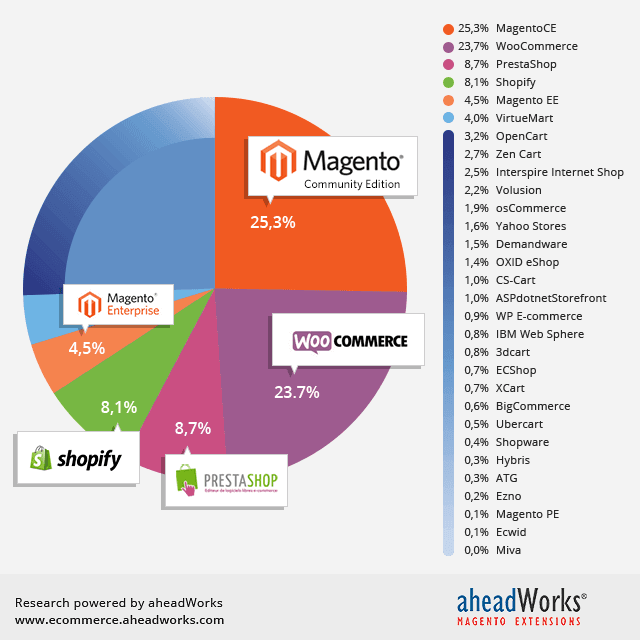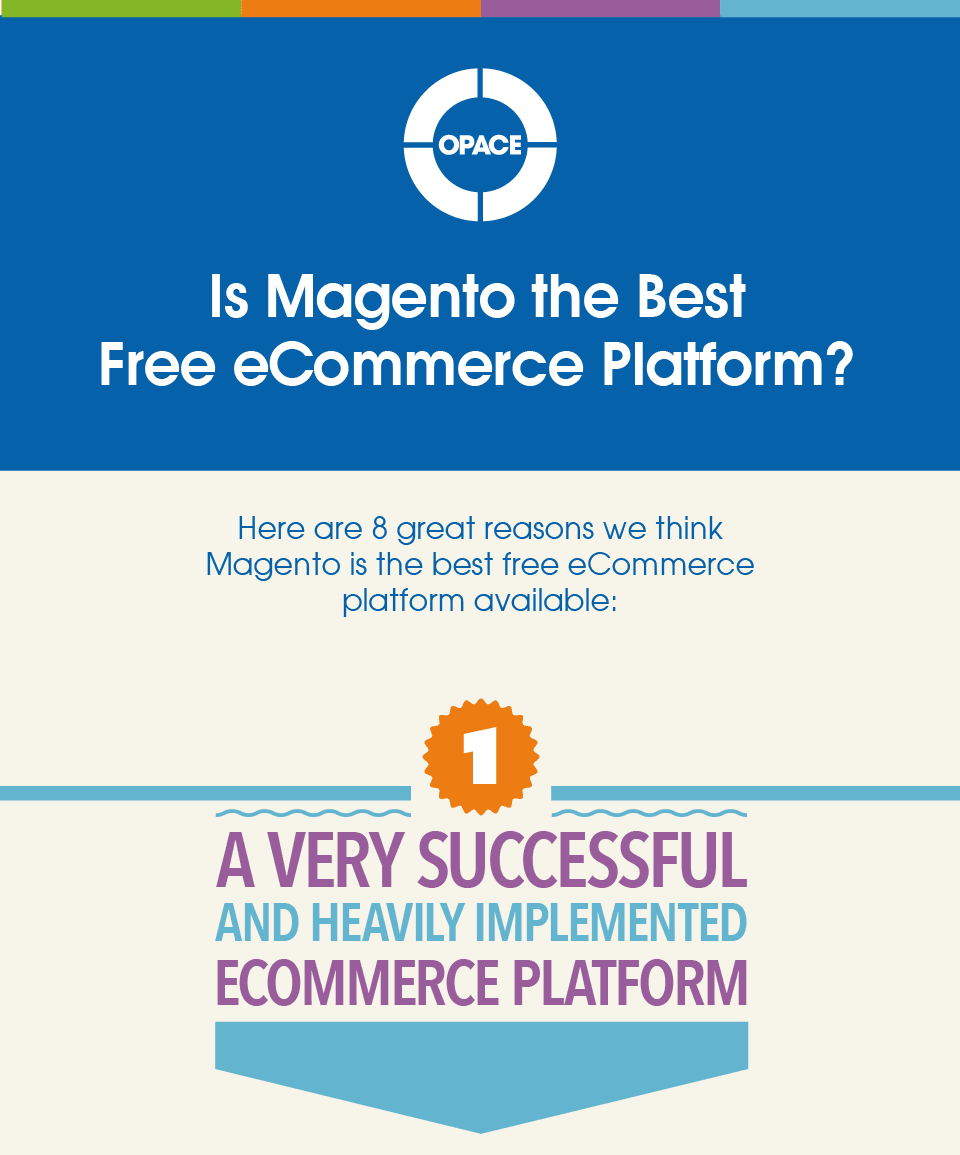As many of our eCommerce customers will know we’re big advocates of Magento here at Opace. In this article we’re exploring Magento 2 and whether it’s still relevant in 2016 and beyond. Magento 2, the eagerly awaited update to the highly popular eCommerce platform Magento, has been available for several months now. It has undergone years of anticipation and speculation as to when/if it would be released, being first announced back in 2010. However after five years it has eventually been released in to a market with much competition. This has led some to some people questioning whether Magento 2 has arrived too late, a question we hope to answer below.
Magento 2 timeline; why the delay?
- 1 Magento 2 timeline; why the delay?
- 2 Who are the competition and what are they doing?
- 3 What’s new with Magento 2?
- 4 Are there problems with Magento 2?
- 5 Who’s using Magento 2?
- 6 What are users of Magento 2 saying?
- 7 So, what do we think here at Opace?
- 8 Magento 2 demos and examples
- 9 What’s next for Magento 2?
- 10 Should you make the move?
- 11 How we can help at Opace
Magento 2 was originally announced way back in 2010, with plans to release it by the end of 2011. So why has it only been released just before 2016? Magento was taken over by eBay in 2011, and neither eBay nor Magento have ever commented on the delay. It was eventually picked back up in 2011 by the new owners and was released for Merchant Beta in early 2015 and is now out for General Availability (https://magento.com/developers/magento2).
The delay was likely due to the fact that eBay spent some time reorganising and adjusting once acquiring Magento, and this wasn’t helped by the fact key management members left, most notably Yoav Kutner, the Co-Founder and former CTO of Magento. He posted a comment, which has since been deleted, alluding to the fact that eBay seemed to have disrupted and changed the original open vision for Magento 2.
Whatever the reasons may have been, Magento 2 has been released much later than planned, and while this may not have been an issue twenty or thirty years ago, the digital age we are now living in means that everyday we’re thinking about what to do next. When we check what competitors are doing we can see that they are out there doing it already. Companies like Uber and Airbnb have come out of almost nowhere and have left many scratching their heads as to how they have managed to dominate so quickly. While Magento has a large share of the eCommerce market, competition is rife, so has this delay affected their place in the market?
Who are the competition and what are they doing?
WooCommerce vs Magento
Perhaps the biggest player in competition with Magento is the WordPress plugin WooCommerce which we also support here at Opace. Woocommerce run a large percentage of the market of all eCommerce stores online and are rapidly growing. This is impressive considering that as a platform they’re only four years old. One of its biggest benefits is that it runs on WordPress, which is one of the most popular open source platforms ever. A major benefit of WordPress is that it offers a much more straightforward CMS (content management system) than Magento, with many users already being familiar with it. WooCommerce is a light piece of software that is not such a drain on resources in the same way that Magento is, but still has hundreds of high quality features and plugins available.
ZenCart vs Magento
Not far behind is ZenCart, which is a much older eCommerce platform, but still accounts for a small percentage of the total eCommerce market, although this is declining. It has been designed with a user-friendly code base, allowing users to adjust some parts of the settings in the code. However, it must be noted that its scope is much smaller in comparison to either WooCommerce or Magento.
osCommerce vs Magento
Like Magento and WordPress, another popular open source platform is osCommerce and is recommended by many large hosting companies. It has a simple interface and a larger support base than ZenCart while also boasting over 7,000 plugins. It also offers excellent support from among the 280,000 forum members, ensuring any question you have never go unanswered and help is always on hand, which is definitely useful if you are only just starting out in the world of online shopping and eCommerce.
So where does Magento fit in amongst this competition?
There is no doubt that they are one of the market leaders in terms of total eCommerce usage count, and the platform has thousands of high-quality templates and extensions available. Many of these templates (often referred to as themes) are also mobile responsive, which is one of the most important factors in Google’s relatively recent algorithm updates which decide how pages are ranked. In the world of online shopping, getting ahead of the competition is a must, and so being responsive is a huge benefit. Magento is also vastly more scalable than the competition listed above and while at first it may be a little more confusing to get your head around, its scope and freedom is unmatched by other eCommerce platforms.
Below we explore just what Magento 2 offers in comparison to the competition and assess whether it is worth making the jump, either from an earlier version of Magento or from a different eCommerce platform.

Ecommerce Platforms Popularity, May 2015: Two Platforms Take Half – courtesy of aheadWorks
What’s new with Magento 2?
There’s no doubt that Magento 2 marks a huge-step up from Magento v1. When designing this system the team at Magento completely overhauled the current platform, stripping it down and building it back up from the very bottom; it seems that rather than thinking about just making upgrades, they had the new era of eCommerce platforms in mind.
Some of these new key features include:
- Scalability – Perhaps the most dramatic change to Magento 2 is the vast improvement on Scalability. They have completely revamped all areas, including the Catalogue, which can now handle up to 10million page views per hour, Checkout which can handle up to 90,000 orders per hour and the Backend by improving order management and product management processes.
- Module Installations & Magento Upgrades – This allows for easier installations and additional checks have been introduced for store stability in the installation of modules and upgrades.
- New UX for Magento Admin – Touch friendly, no hover states and screen optimised for tablet or mobile devices. It also brings with it flexible data grids, drag and drop reordering, custom views and configurable controls for much greater control.
- New M Connect – It is now easier to upload, sell and track for developers, there is improved search and quality, automated scans for plagiarism as well as new coding standards which also introduces code safety vulnerabilities.
- Product Import/Export Improvements – Magento can now handle a much larger quantity of product imports and exports, with 100K records in 25 minutes (VM 8cpu, 24gb RAM). This results in merchants now being able to add products much faster.
These are just a few of the changes that have been added to the overhauled Magento 2 system, and performance, stability and efficiency were always at the forefront of designer’s minds. It will now use PHP 5.4 & 5.5, HTML 5 and CSS3, as well as moving from Prototype.js to jQuery. Alongside this, it will support more modern coding standards, increase page loading times (something that Magento users have been waiting a long time for), refactor indexers to work in the background, as well as an updated technology stack, streamlined customisation processes and better all round installation and ease of use.
Upon release, Magento stated that Magento 2 will be used to empower brands, retailers and businesses with a quick and cost-effective omnichannel shopping experience. They also said that it offers enhance performance and scalability, comes with new features that will increase conversion rates and productivity. It all sounds like the last few years have been worth the wait, but are there any problems with Magento 2?

Demo of responsive Magento 2 across all devices – Magento.com
Are there problems with Magento 2?
The first issue that we’ve encountered and probably the biggest issue for any existing Magento users, is that it’s not an easy process to migrate from Magento v1 to Magento v2.
A full audit of all third party extensions needs to be completed, as well as reviewing and analysing existing template code and modules, all of which can be a lengthy process. Many of the extensions may need to be upgraded, replaced or even rebuilt. This will undoubtedly incur additional cost. The template itself will most likely need to be redeveloped in order to be compatible with Magento 2, a process which can be time consuming and costly. The good news is that many of the more popular extension suppliers have already released v2.0 versions of their components. A handful of template providers have done the same, one of our favourites is the incredibly powerful Porto theme which now supports Magento 2.
Unlike smaller CMS systems like WordPress, Magento is an extremely complex system and as such isn’t a case of ‘one-click’ and you’re done. Even with upgrades within Magento v1, the process can be a lot more time consuming than with platforms like WordPress. The Magento platform is used by a wide range of companies, but many of these have a digital turnover of more than £100,000 a year and so the likelihood is that these companies cannot afford to have their websites taken offline for migration at the cost of thousands of pounds worth of sales and customer retention. However, this isn’t a negative specific to Magento 2, any large new software update with new features and benefits will require some migration or update process. It’s simply a necessary step in improving performance and having the latest innovation and technology.
Who’s using Magento 2?
A number of high-end businesses have already made the switch to Magento 2 during it’s Merchant Beta phase, such as Alcatel Onetouch, SEAT, and Venroy. This joins an already impressive client list of companies such as Nike, Christian Louboutin and OfficeMax.
What are users of Magento 2 saying?
Magento 2 hasn’t always been received with universal acclaim, and reviews remain mixed. Danny Decker, from Harlo Interactive, tested Magento 2 early on, before Beta release and believes that it delivers nothing new from its predecessor, offering many of the same features as Magento V1. According to him Magento 2 does great things for developers, but it doesn’t really do anything to advance merchants’ needs. However, as his comments were made over a year ago, many of the issues that he’s raised seem to have already been resolved. Some still don’t believe it is worth making the jump yet, such as Ecommerce news, who believe that it will be at least another year before merchants are really able to make use of the new software: http://ecommercenews.eu/magento-2-finally-still-relevant. However, others believe that Magento 2 is by far the best eCommerce platform on the market and some sites give it an almost perfect five out of five review: http://ecommerce-platforms.com/ecommerce-reviews/the-ultimate-magento-ecommerce-review-2015.
Some minor issues for Magento 2 are also listed in this forum here: https://github.com/magento/magento2/issues.
So, what do we think here at Opace?
Magento 2 is still in its early release stages, and it may be some time before all the creases are properly ironed out, but the new features and performance capabilities at release are already extensive. Some may be cautious about switching too early, but Magento v1 will be slowly phased out over the next few years, with Magento committing to only supporting it until the end of 2018. This means that more problems are going to arise for users of Magento v1 over the coming months and years. For example, already earlier versions of Magento do not work on newer versions of PHP.
Stability is not as much as an issue with Magento 2; in fact stability was a key target for increased performance while 2.0 underwent development. The product has been through rigorous testing, as well as exhaustive quality assurance, by both the Magento team and external, real merchant testers when it was released for Merchant Beta.
Full page caching allows for faster page load speeds, a basic but essential feature which will greatly improve user experience, as well as state-of-the-art tech in the form of HTML 5 and a revamped CSS pre-processor to create a more stable, more efficient system. Having said this, vast improvements can also be made with Magento 1 investigating into high quality dedicated hosting, potentially CDN usage, caching extensions, template and code optimisation, image compression, use of image sprites, and so on. Many of these are still important factors, even with Magento 2.
While any new software update may experience some small issues at early release, these are things that can be quickly rectified. Overall, Magento 2 is suffering from no major problems that would we would say justify a decision not to migrate, unless it’s simply not not feasible for your business at this time, due to business or budgetary constraints. If this is the case, then you at the very least should be using the latest version of Magento 1.9 with any critical patches applied, for both security and stability purposes.
Availability of extensions and themes compatible with Magento 2
As we’ve mentioned already, Magento 2 is in its early stages, so many third party extensions are not yet available on the system but this will change quickly, although some suppliers may decide to wait until Magento 2 is more established. Our view is that Magento 2 is simply the next step in the already well established Magento name, so this won’t take long.
Despite many third party extensions being not yet available, there are still a large number of extensions available for download, such as MageMonkey for services like MailChimp, Twitter & Facebook Logins, McAfee SECURE, Brand Slider and Apply Coupon Code Link. A complete list of available extensions can be seen here: https://www.magentocommerce.com/magento-connect/magento-2.

Magento 2’s modern tech stack – magento.com
Magento 2 demos and examples
As covered above, some companies took the leap and adopted Magento 2 during its early Magento release and their websites can be seen here:
- Alcatel Onetouch – http://www.alcatelonetouch.us
- SEAT – https://shopworld.seat.de
- Venroy – https://www.venroy.com.au
Alternatively, for a live demo version, following this link here using the services provided by UberTheme: https://www.ubertheme.com/magento-news/magento-2-demo-sample-data-admin-access
- Front end: http://magento2.demo.ubertheme.com
- Admin: http://magento2.demo.ubertheme.com/admin
- Username : uber Password : uber123
What’s next for Magento 2?
The team at Magento have already planned an extensive amount of releases and updates, ensuring they constantly and consistently build on the developments of the last few years, also incorporating in user feedback. As seen from the image below, they have planned releases in each quarter of 2016 and Magento 2.1 has already been released, offering compatibility with PHP 7.0.2 to offer dramatic performance improvements, reduction in memory consumptions and support for new PHP language features.
There are added security enhancements despite the fact that there are no confirmed attacks on Magento 2 as of this stage. Some of these security fixes include SQL injection, the ability for unauthenticated users to delete any product review from the storefront and stopping attackers being able to access order information in the store.

Magento’s 2016 Update Schedule
The full slideshow that this was taken from is available here: http://www.slideshare.net/Amasty/meet-magento-belarus-elena-leonova.
Should you make the move?
In short, we would say yes. There is a large amount of competition in the eCommerce market, but the benefit of a wide range of competition means that each player has to be constantly improving their game with the latest innovation and the greatest possible consumer experience, and Magento, being the market leaders, have certainly delivered on this front. While some platforms, like WooCommerce, are initially easier to use, Magento offers an unmatchable level of scope, scalability and flexibility, and gives you the chance to really build your business in a way that other eCommerce platforms cannot.
If you are already a Magento user with version 1.9 or higher, you can make the switch and although this may cost both time and money, the benefits far outweigh the temporary inconveniences. It will eventually be compulsory to upgrade to Magento 2 anyway. Users who are new to Magento and are still to set up their eCommerce business can choose to go with either the older v1 platform, the newer 2.x version or of course a different platform entirely. This is down to personal preference, although our recommendation for larger eCommerce businesses is nearly also to use Magento and for any new businesses we would be recommending they start with v2.

Infographic from Opace: Is Magento the best free eCommerce platform?
How we can help at Opace
Our team of developers are well experienced in all things Magento, and are on hand to help you with installation, configuration, testing and troubleshooting. If you are interested in using our full upgrade service in the near future, are looking to move to Magento or just have a question, feel free to get in touch and discuss it with one of our developers at www.opace.agency.
For further information please visit https://opace.agency/services/ecommerce/magento-web-design-development, get in touch or call us at 0121 468 0600. If you have any comments, thoughts or opinions on our article please leave a comment.
Image credits: magento, https://vimeo.com/145947978 and https://vimeo.com/145947876.






Nice post! Thanks for sharing this.
Such a good post, Thanks for sharing here.
Keep doing it.
Magento Extension Developers